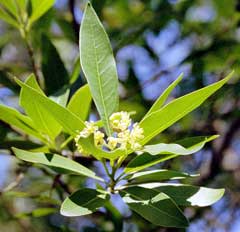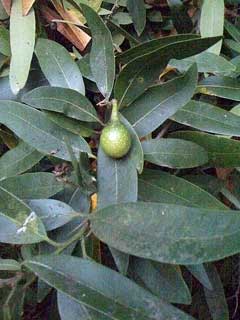 |
|
commons.wikimedia.org/wiki/User:Elf |
 |
|
Translate this page:
Summary
Bloom Color: Yellow. Main Bloom Time: Early spring, Early winter, Late winter, Mid spring, Mid winter. Form: Rounded, Vase.
Physical Characteristics

 Umbellularia californica is an evergreen Tree growing to 25 m (82ft) by 10 m (32ft) at a medium rate.
Umbellularia californica is an evergreen Tree growing to 25 m (82ft) by 10 m (32ft) at a medium rate.
See above for USDA hardiness. It is hardy to UK zone 7 and is not frost tender. It is in leaf all year, in flower in April, and the seeds ripen from October to November. The species is hermaphrodite (has both male and female organs).
Suitable for: light (sandy), medium (loamy) and heavy (clay) soils and prefers well-drained soil. Suitable pH: mildly acid and neutral soils. It cannot grow in the shade. It prefers moist soil.
UK Hardiness Map
US Hardiness Map
Synonyms
Laurus regalis. L. regia. Oreodaphne californica. Tetranthera californica.
Plant Habitats
Woodland Garden Canopy;
Edible Uses
Edible Parts: Fruit Seed
Edible Uses: Coffee Condiment
Seed - cooked[257]. It can be roasted and eaten or can be ground into a powder that is used with cereal flours in making bread[62, 105, 177, 183]. A bitter quality in the seed is dispensed by roasting or parching the seed[92, 161]. Fruit - raw or cooked[257]. The leaves are used as a condiment in cooked foods. They are a bayleaf substitute but with a much stronger flavour[2, 94, 238]. Used for flavouring soups, stews etc[183]. A tea is obtained from the leaves[2]. A coffee substitute is obtained from the root bark[161, 183].
References More on Edible Uses
Medicinal Uses
Plants For A Future can not take any responsibility for any adverse effects from the use of plants. Always seek advice from a professional before using a plant medicinally.
Analgesic Antirheumatic Nervine Poultice Salve Stimulant Stomachic
California laurel was employed medicinally by some native North American Indian tribes who used it particularly as an analgesic to treat a variety of complaints[257]. It is still occasionally used in modern herbalism, being valued for its beneficial effect upon the digestive system. The leaves are analgesic, antirheumatic, nervine and stomachic[92, 94, 95, 238, 257]. Although the aroma of the leaves is known to cause headaches, they have also been used as an infusion and a poultice to treat this affliction[92, 94, 95, 238, 257]. The leaves are also used internally to treat neuralgia, intestinal cramps and gastro-enteritis[238]. An infusion has been used by women to ease the pains of afterbirth[257]. Externally, an infusion has been used as a bath in the treatment of rheumatism[257]. A decoction of the leaves has been used as a wash on sores and to remove vermin from the head[257]. They are harvested as required and can be used fresh or dried[238]. A poultice of the ground seeds has been used to treat sores[257]. The seeds have been eaten as a stimulant[257].
References More on Medicinal Uses
The Bookshop: Edible Plant Books
Our Latest books on Perennial Plants For Food Forests and Permaculture Gardens in paperback or digital formats.

Edible Tropical Plants
Food Forest Plants for Hotter Conditions: 250+ Plants For Tropical Food Forests & Permaculture Gardens.
More

Edible Temperate Plants
Plants for Your Food Forest: 500 Plants for Temperate Food Forests & Permaculture Gardens.
More

More Books
PFAF have eight books available in paperback and digital formats. Browse the shop for more information.
Shop Now
Other Uses
Dye Essential Incense Repellent Wood
The leaves are used as an insect repellent, they are especially effective against fleas[62, 92, 94, 95, 169]. They have disinfectant properties and contain small quantities of camphor[95, 169]. The leaves are burnt as a fumigant to get rid of fleas[257]. The leaves have been hung in bunches to freshen the air[257]. The aroma of the leaves gives some people headaches[K]. An essential oil is obtained from the leaves by steam distillation[11, 46, 61, 82]. Beige and green dyes are obtained from the fruits (used without the seeds). Very aromatic, the dye retains its fragrance for many years[168]. Wood - hard, close grained, heavy, strong, takes a high polish. A beautifully textured wood, it is used for high quality cabinet making, panelling etc[61, 82, 94, 229].
Special Uses
Scented Plants
References More on Other Uses
Cultivation details
Landscape Uses:Hedge, Aggressive surface roots possible, Screen, Specimen, Street tree, Woodland garden. Requires a well-drained moisture retentive lime-free soil in a sunny position[200]. Prefers an abundant supply of moisture in the growing season[82]. Older plants are hardy to about -15°c when growing in a position that is sheltered from cold drying winds, but young plants require some frost protection[200]. Even mature plants can be damaged in severe winters[1]. The leaves are harvested commercially in California and sold as a bay-leaf substitute[183]. The leaves emit a powerful camphor-like scent when bruised[245]. So strong is the aroma that it can cause headaches and dizziness[245]. A very large and beautiful tree fruited regularly at Kew, producing viable seed, until it was blown down in the severe storms of October 1987[K]. Special Features:Attracts birds, North American native, Fragrant foliage, Inconspicuous flowers or blooms.
References Carbon Farming Information and Carbon Sequestration Information
Temperature Converter
Type a value in the Celsius field to convert the value to Fahrenheit:
Fahrenheit:
The PFAF Bookshop
Plants For A Future have a number of books available in paperback and digital form. Book titles include Edible Plants, Edible Perennials, Edible Trees,Edible Shrubs, Woodland Gardening, and Temperate Food Forest Plants. Our new book is Food Forest Plants For Hotter Conditions (Tropical and Sub-Tropical).
Shop Now
Plant Propagation
Seed - it has a limited viability and is best sown as soon as it is ripe in the autumn in a greenhouse[200]. Stored seed should be sown as early in the year as possible in the greenhouse. In the wild the seed germinates as soon as it falls to the ground in the autumn[82]. When they are large enough to handle, prick the seedlings out into individual pots and grow them on in the greenhouse for at least their first winter. Plant them out into their permanent positions in late spring or early summer, after the last expected frosts. Cuttings of half-ripe wood, 7 - 10cm with a heel, July/August in a shaded frame. Pot up in spring. Good percentage[78, 200]. Layering.
Other Names
If available other names are mentioned here
Native Range
NORTHERN AMERICA: United States (Oregon, California), Mexico (Baja California (Norte))
Weed Potential
Right plant wrong place. We are currently updating this section.
Please note that a plant may be invasive in one area but may not in your area so it's worth checking.
Conservation Status
IUCN Red List of Threatened Plants Status :

Growth: S = slow M = medium F = fast. Soil: L = light (sandy) M = medium H = heavy (clay). pH: A = acid N = neutral B = basic (alkaline). Shade: F = full shade S = semi-shade N = no shade. Moisture: D = dry M = Moist We = wet Wa = water.
Now available:
Food Forest Plants for Mediterranean Conditions
350+ Perennial Plants For Mediterranean and Drier Food Forests and Permaculture Gardens.
[Paperback and eBook]
This is the third in Plants For A Future's series of plant guides for food forests tailored to
specific climate zones. Following volumes on temperate and tropical ecosystems, this book focuses
on species suited to Mediterranean conditions—regions with hot, dry summers and cool, wet winters,
often facing the added challenge of climate change.
Read More
Expert comment
Author
(Hook.&Arn.)Nutt.
Botanical References
11200
Links / References
For a list of references used on this page please go here
Readers comment